Subscriber Exclusive
Making a Simple Shaft-Switching Device
Here are directions for making a manual shaft-switching device for weaving weft-faced rugs.
Here are directions for making a manual shaft-switching device for weaving weft-faced rugs. <a href="https://handwovenmagazine.com/making-a-simple-shaft-switching-device/">Continue reading.</a>
https://handwovenmagazine.com/cdn-cgi/image/format=auto/https://www.datocms-assets.com/75077/1656664630-making-a-simple-device-1.jpg?auto=format&w=900
There are very few new ideas in the field of textiles. Let’s face it; whatever we dream up, most likely someone else in the last twelve thousand years has probably woven it somewhere sometime. But the combination of Peter Collingwood’s pure genius and the need to weave patterned rugs quickly enough to be saleble led him to develop the technique he named shaft-switching. In 1968, he introduced the weaving world to shaft-switching in The Techniques of Rug Weaving (see Resources below).
In the 1980s, Harrisville Designs approached Collingwood and asked for his help in developing a new rug loom that would include his design for a shaft-switching device. What came from their collaboration is probably the finest rug loom that has ever been built. If you are planning to weave a great many rugs, you’ll want to consider a Harrisville rug loom. But for the average weaver who would like to weave only a rug or two, here is a way to add a shaft-switching device to your loom.
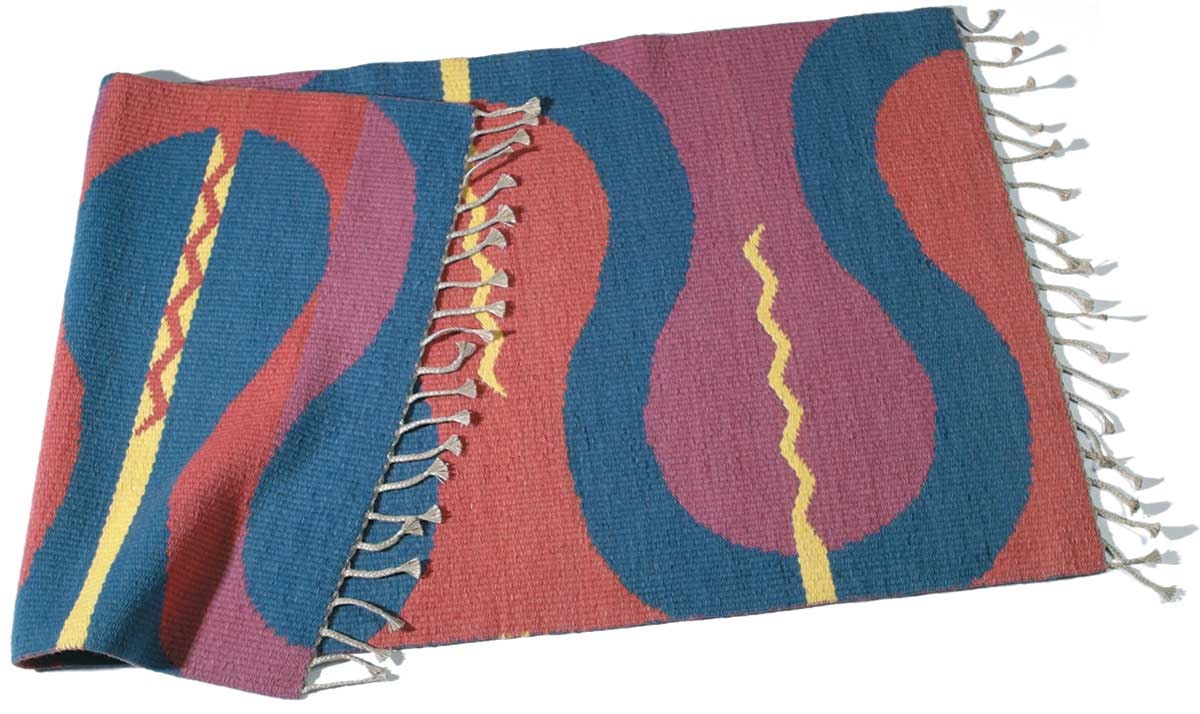
Meander, 41" x 70", by Emilie Pritchard is a shaft-switched rug with a linen warp and a hand-dyed wool weft. Even with shaft-switching, taqueté has one constraint: only two colors can weave selvedge to selvedge in any one row. Emilie enjoys creating complex designs that look as if there are more colors. Follow the rows of weft in this rug and in Woven Ribbons to see how she achieves a more complex look.
SUBSCRIBER EXCLUSIVE
There are very few new ideas in the field of textiles. Let’s face it; whatever we dream up, most likely someone else in the last twelve thousand years has probably woven it somewhere sometime. But the combination of Peter Collingwood’s pure genius and the need to weave patterned rugs quickly enough to be saleble led him to develop the technique he named shaft-switching. In 1968, he introduced the weaving world to shaft-switching in The Techniques of Rug Weaving (see Resources below).
In the 1980s, Harrisville Designs approached Collingwood and asked for his help in developing a new rug loom that would include his design for a shaft-switching device. What came from their collaboration is probably the finest rug loom that has ever been built. If you are planning to weave a great many rugs, you’ll want to consider a Harrisville rug loom. But for the average weaver who would like to weave only a rug or two, here is a way to add a shaft-switching device to your loom.

Meander, 41" x 70", by Emilie Pritchard is a shaft-switched rug with a linen warp and a hand-dyed wool weft. Even with shaft-switching, taqueté has one constraint: only two colors can weave selvedge to selvedge in any one row. Emilie enjoys creating complex designs that look as if there are more colors. Follow the rows of weft in this rug and in Woven Ribbons to see how she achieves a more complex look.
[PAYWALL]
How shaft-switching works
Shaft-switching is used for weft-faced weaves that are woven on a summer and winter (or similar) threading in which Block A = 1-3-2-3 and Block B = 1-4-2-4. Two different-colored wefts weave alternately with shafts 1 and 2. Shafts 3 and 4 control the pattern. If either shaft is down when one of the colors weaves, the color shows on the face; if the shaft is up, the color shows on the back, and vice versa
Frustrated by the design limitations of two blocks, Peter realized that he would have limitless designing freedom if he could move the warp threads from shaft 3 to shaft 4 or from 4 to 3 at will. The idea is fantastic—but how to do it without cutting or untying warp threads?
Simple! You don’t move the warp threads—you move the heddles. After numerous experiments the dream became a reality and shaft-switching was born.
The shaft-switching device
Instead of shifting from shafts 3 to 4, Peter found it was more convenient mechanically to shift from 1 to 4 (shifting from 1 to 2 is another option, placing the switching process closer to the front of the loom). The summer and winter threading is therefore rewritten so that 1-3/4-2-3/4 becomes 2-1/4-3-1/4. Shafts 1 and 2 become 2 and 3, and the shafts that switch change from 3/4 to 1/4.
To construct the device, first cut lengths of Texsolv cord about 30" long (or length suitable for your loom; see below) equal to the number of switching ends you need (97 for Emilie Pritchard’s rug). Mark the loop in the center of the cord with a permanent marker. Thread each cord through the eyes of a heddle on shaft 1 and a heddle on shaft 4. (Texsolv cord is looped nylon cord in several sizes; choose the smallest at 25 loops per inch.)
To determine the 30" length, I measured the distance from the top of shaft frame 1 to the heddle eye on frame 1 and then back to the heddle eye on shaft frame 4. I doubled this measurement and added a few inches for joining the two ends at the top of the frame. (Inserted-eye heddles are recommended since they allow the Texsolv cord to slide more freely than wire or flat steel heddles.)
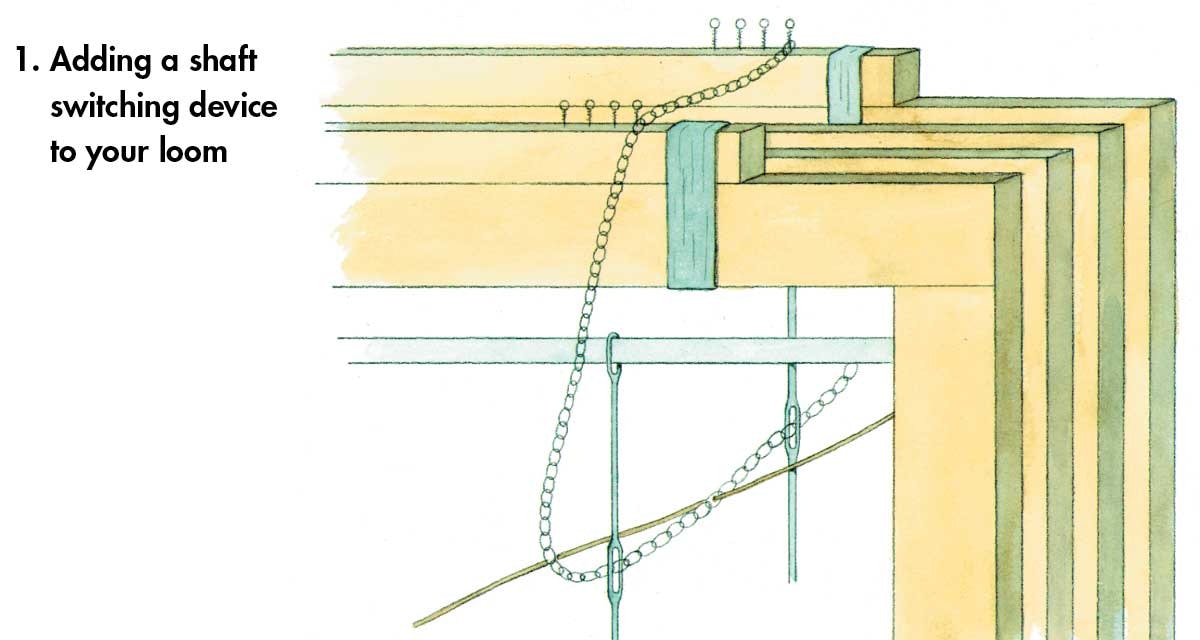
Threading the shaft-switching loops
Wind a warp, spread it in a raddle at the desired width, and beam. Thread the first end on shaft 2. The next end is a shaft-switching end. Slide a heddle from shaft 1 and a heddle from shaft 4 into a position for threading and thread one of the Texsolv cords through the eyes of both heddles. Place the cord so the marked loop is located between the heddles. Now thread the second warp end through the marked loop by bringing the warp end to the right of the heddle on shaft 4, through the loop and forward to the left of the heddle on shaft 1. Thread the third end on shaft 3, and thread the fourth end the same way as the second end; see Figure 3.
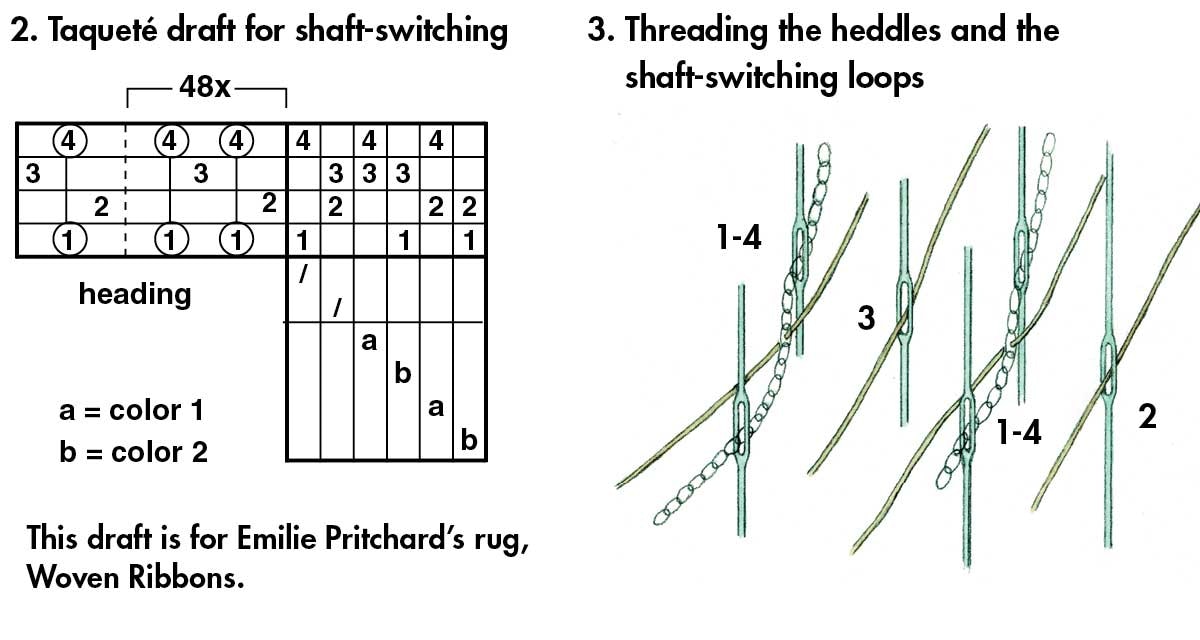
After threading the shaft-switching end and bringing it forward toward you, take a moment to see how the shaft-switching loop works. Hold onto the ends of the Texsolv cord and move it back and forth. See how it makes the warp end move to shaft 4 when you pull the cord to the back and then to shaft 1 when you pull the cord to the front?
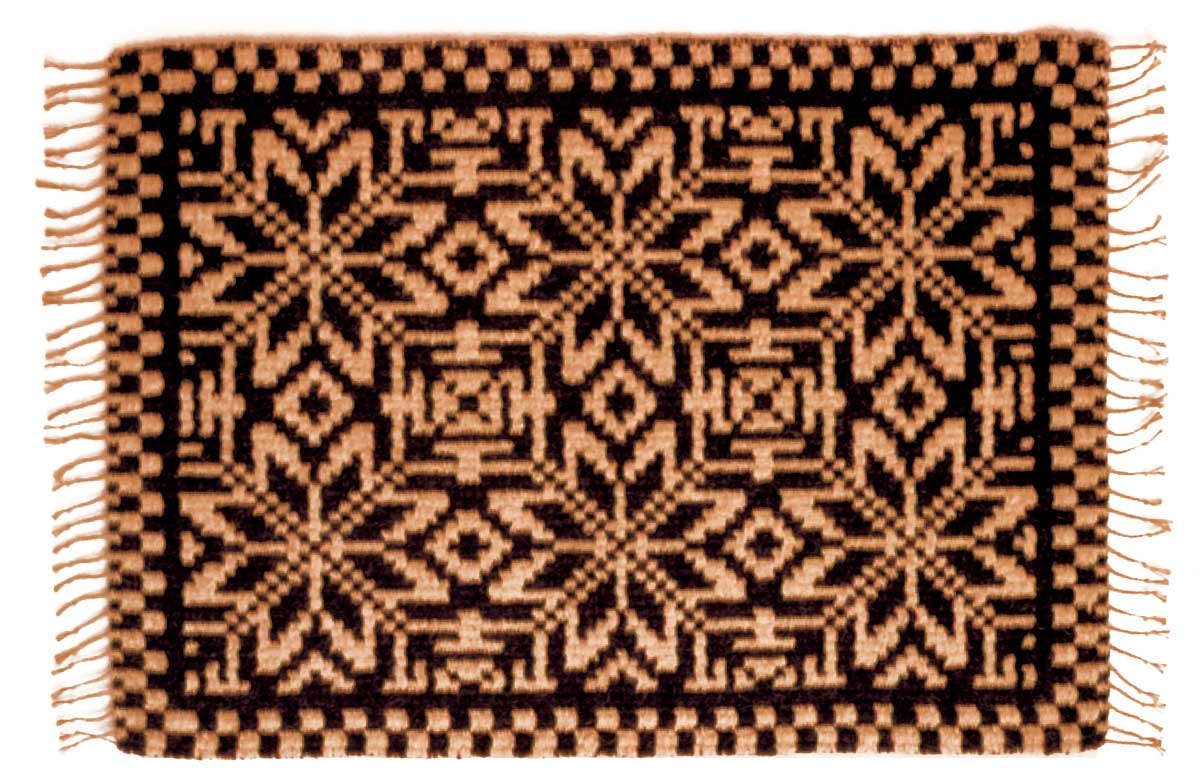
Kimberly Kerley adapted the design for her Eastern Star rug (34" x 48") from a knitting pattern. It was woven on a Harrisville Designs rug loom in taqueté using shaft-switching. The warp is linen and the weft is both commercial wool and Navajo-Churro wool.
Securing the shaft-switching cords
Attach to shafts 1 and 4 two pieces of thin wood each 1" high by 3⁄8" thick and as long as the top of the shaft frames. Place screw eyes at the desired sett for the switching ends. (There are five screw eyes in every 2" for Emilie Pritchard’s rug since the warp sett is 5 working ends per inch. Most shaft-switching devices place the screw eyes at every half inch, partly because it’s easy to measure, and 4-dent and 8-dent reeds are more readily available than 5-dent reeds.)
The screw eyes should be about 1⁄4" inch wide at the widest point so the Texsolv loops can slide easily over them. You may want to take a sample of the cord with you to the hardware store. (The store clerk in my case wanted to know where they could get this very cool cord! He was surprised at my answer: any weaving store.) You’ll need two screw eyes per threading repeat for both front and back strips, 194 total for Emilie Pritchard’s setup.
Mark the position for the screw eyes with a pencil, drill small holes as starts, and screw the screw eyes in both boards. Attach the boards to the top of the frame with tape (I used ever-handy duct tape).
With the shaft-switcher strips in place and the Texsolv cords threaded through the heddles, bring the ends of each cord up to meet between the screw eyes and join them with a colored thread (these can be color coded to aid in counting).
Next, move each shaft-switching cord to a position that snugs the warp thread to its heddle on shaft 1, slide the Texsolv loop over the screw eye, and mark the loop. Then move the cord to a position that snugs the warp thread to its heddle on shaft 4 and mark the corresponding loop.
When you are ready to weave, consult your design graph and place the switchers that correspond to one of your weft colors in the marked loops on shaft 1 and those that correspond to the other weft color in the marked loops on shaft 4.
Then treadle the 4-pick sequence alternating two colors for the height of your pattern row. Happy weaving!
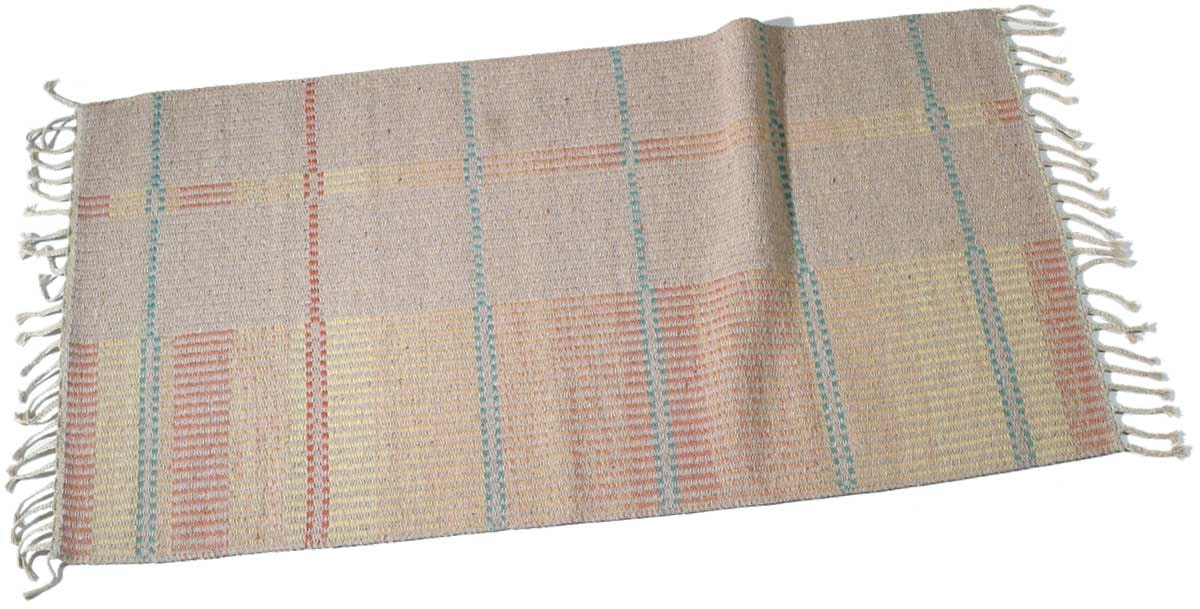
Barbara Stafford used the three-end block weave favored by Peter Collingwood for her rug (32" x 60", below). Although Barbara weaves on a Harrisville Designs shaft-switching rug loom, the design for this rug is a 2-block design and can be woven on only four shafts. She likes to weave several rugs on the same long warp, some that make use of the shaft-switching device and some that do not. Sometimes the simplest designs blend best with furnishings and floorings.
Resources
- Collingwood, Jason. Video. Block Weaves and shaft-switching. Lawrence, Kansas: Victorian Video Productions, 1999.
- Collingwood, Peter. The Techniques of Rug Weaving. New York: Watson Guptill, 1979.
- ———. Rug Weaving Techniques Beyond the Basics. Loveland, Colorado: Interweave Press, 1990.
- Rohde, Michael. “Block Weave Rugs,” Handwoven, May/June 2000, pp. 44–47.
- Stanley, Martha. A Rug Weaver’s Source Book. Loveland, Colorado: Interweave Press, 1984, pp. 166–167.






